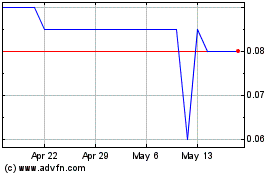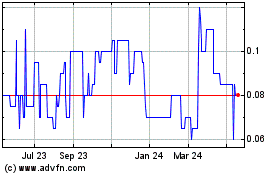Compass Gold Corp. (TSX-V: CVB) (Compass or
the Company) is pleased to provide an update on
the results of the one diamond drill hole completed on extensive
artisanal workings at the Ouassada exploration permit on its
Sikasso Property in Southern Mali.
Highlights
- Identified three discrete mineralized zones within an
18 m-wide interval
- 4 m @ 83.82 g/t Au (from 63 m)
- 4 m @ 7.04 g/t Au (from 69 m)
- 3 m @ 4.18 g/t Au (from 78 m)
- 1 m interval (with a 45 cm true thickness vein)
contained 329.92 grams per tonne gold (g/t Au)
- Mineralization correlated well with adjacent reverse
circulation (RC) drill holes and a 1,600 m target structure
identified during recent ground geophysics
- 1,000 m drill program planned at Farabakoura to test
additional structures.
Compass CEO, Larry Phillips,
said, “The results from our first diamond drilling thus far at
Farabakoura are exceptional. While the 330 g/t Au (10.6 troy
ounces per tonne) interval reflects the nuggety nature of the gold,
it is important to note that the three mineralized structures
around it correlated with what we found in the adjacent RC holes
drilled in December. Looking at the larger picture, we also
see that the mineralization drilled to date at Farabakoura is
coincident with structures identified from our ground geophysical
surveys. We’re looking forward to starting to further drill
test these trends soon, which are up to 1,600 m in length, to
determine the full extent of the mineralization in this highly
prospective portion of our permits.”
Diamond Drilling (Farabakoura)
As previously announced (see Compass news releases dated January 10
and February 14, 2019), a single 201 m inclined diamond drill hole,
OUDD001, was drilled in early January 2019 beneath the artisanal
gold working at Farabakoura, Ouassada permit. The purpose of
the hole was to provide information on rock types, structure and
the nature of mineralization encountered in two adjacent, 10 m
away, reverse circulation (RC) drill holes (OURC004 and
OURC005). OURC004 contained a 37-m mineralized zone with 0.87
grams per tonne gold (g/t Au), which included intervals of 10 m @
2.25 g/t Au (from 29 m), and 9 m @ 0.84 g/t Au (from 59 m).
OURC005 contained two broad mineralized zones. The first zone
was a 46-m mineralized zone with 0.66 g/t Au (from 18 m), which
included intervals of 6 m @ 0.53 g/t Au (from 18 m), and 13 m @
1.97 g/t Au (from 51 m). The second zone was 27 m @ 0.92 g/t
Au (from 96 m), which included 16 m @ 1.47 g/t Au (from 96
m).
Figure
1. Location of OUDD001 (red text) in
relation to the adjacent drill holes at
Farabakoura.http://www.globenewswire.com/NewsRoom/AttachmentNg/6f3400a8-b680-4e21-a8b8-acf472220d13
Drill hole OUDD001 was drilled 10 m to the
southeast of OURC005 using the same angle (60°) and azimuth
(050°). Upon completion, the hole was surveyed, the recovered
core logged, and samples (with an appropriate number of standards,
blanks and duplicates) sent to the assay laboratory (SGS, Bamako)
for geochemical analysis. The most significant intervals are
presented in Table 1.
Table 1. Drill
intersections from OUDD001 at Farabakoura
|
MineralizedZone |
1Interval and 2,3Gold Grade |
From Depth (down hole) |
|
1 |
1 m @ 4.54 g/t Au |
22 m |
|
2 |
18 m @ 20.69 g/t Au |
63 m |
|
including |
4 m @ 83.32 g/t Au |
66 m |
|
[Including |
1 m @ 329.92 g/t Au |
66 m] |
|
including |
4 m @ 7.04 g/t Au |
69 m |
|
including |
3 m @ 4.18 g/t Au |
78 m |
|
3 |
9 m @ 0.23 g/t Au |
102 m |
|
4 |
7 m @ 0.20 g/t Au |
138 m |
|
5 |
1 m @ 0.39 g/t Au |
164 m |
1True thicknesses are interpreted as 60-90% of
stated intervals2No top-cut has been used on analyses3Intervals use
a 0.2 gram per tonne gold cut-off value
Mineralization was present in seven discrete
zones, with the highest grades present within the top 81 m of the
core (or 70 m from surface). Numerous instances of visible
gold were observed between 63.2 m and 72.2 m and this is reflected
in the extremely high gold grades determined by assaying. A
reanalysis of the 329.92 g/t Au (10.6 oz/t Au) interval returned a
grade of 361.48 g/t (11.6 oz/t Au). Gold enrichment caused
surficial oxidation is unlikely, since unaltered bedrock was
encountered at 31 m and the pyrite does not show signs of
alteration. The 18 m @ 20.69 g/t Au mineralized interval in
OUDD01 appears to correlate with the 13 m @ 1.98 g/t Au interval in
OURC05.
Geological Interpretation
Logging of chips from OURC004 and OURC005
suggested that mineralization was present within a granodiorite, at
the contact between a granodiorite and metavolcaniclastics, and
within the metavolcaniclastic unit. The preliminary
interpretation was that mineralization was both controlled by the
intrusion of the granodiorite, and later faults cutting the
units. The field relationship of the mineralization to the
host rock was not known, and the true thickness of mineralization
could not be determined.
Logging of the diamond hole indicated that the
mineralization is generally hosted within a thick intercalated
sequence of volcaniclastic metasedimentary rocks that vary from
coarse- to fine- grain-size, which have been extensively deformed
due to regional metamorphism. A weakly metamorphosed
granodiorite is present at the top of the hole.
Mineralization takes two forms: zones of silicified,
pyrite-rich (5-8%) metasedimentry rock generally conformable to
foliation (60-65°), and slightly lower-angle (40-45°) discordant
mineralization in thin (2-5 cm) quartz-carbonate veins. This
could indicate gold remobilization due to later structural
events. Core measurements indicated that mineralization is
dipping steeply to the southwest. This is in good agreement
with the previously drilled RC holes, and also the recently
interpreted ground geophysics (Compass news release dated March 26,
2019).
Three zones of low-grade gold mineralization are
noted at depths greater than 102 m. In each case, the gold is
associated with a chlorite-rich schist unit in the rock package
that is sometimes cut by fragmented and discontinuous
quartz-sulphide veins. This pyrite appears to be stratabound
(occurring between layers), and probably represents primary gold
mineralization. It is likely that the 9 m @ 0.23 g/t Au (from
102 m) interval correlates with a 16 m @ 1.47 g/t Au (from 96 m)
interval in OURC05. The presence of sulphide- and/or graphite-rich
lithologies are indicated from the IP survey data, and structures
(faults) and intrusions are interpreted from the ground magnetic
survey data (see Figure 2). These targets could host gold
mineralization, and are the focus of a planned short drilling
program.
Next Steps:
As noted in the Company’s news release dated
February 26, 2019, a 1,000-m RC drilling program will be initiated
shortly at Farabakoura. The purpose of this program is to
determine whether mineralization is present in the structures
recently identified using detailed ground geophysics. These
structures can be traced for up to 1,600 m and have geophysical
signatures similar to areas where gold mineralization was
encountered. Additional bedrock drilling will take place on
the remaining targets on the Ouassada and Faraba-Coura permits once
the permit wide IP survey is completed and interpreted.
Field teams are continuing to perform sampling
at nine artisanal gold sites on the Yanfolila South block, and
assay results will be released once this program is complete.
It is anticipated that limited bedrock drilling can take place on
some of these workings prior to the beginning of the rainy season
in late June.
Figure
2. Results of the filter-enhanced
high-resolution ground magnetic survey with target structures
(yellow lines) superimposed at Farabakoura. The locations of
the IP lines are also
identified.http://www.globenewswire.com/NewsRoom/AttachmentNg/250362e6-898f-490e-a497-ae390e87c4b0
About Compass Gold Corp.
Compass, a public company having been
incorporated into Ontario, is a Tier 2 issuer on the
TSX- Venture Exchange (TSX-V). Through the 2017 acquisition of
MGE and Malian subsidiaries, Compass holds gold exploration permits
in Mali that comprise the Sikasso Property. The
exploration permits are located in three sites in southern Mali
with a combined land holding of 854 km2. The
Sikasso Property is in the same region as several multi-million
ounce gold projects, including Morila, Syama, Kalana and
Kodiéran. The Company’s Mali-based technical team, led in the
field by Dr. Madani Diallo and under the supervision of Dr. Sandy
Archibald, P.Geo, is executing a technically-driven and
comprehensive exploration program. They are examining numerous
anomalies noted for further investigation in Dr. Archibald’s August
2017 *“National Instrument 43-101 Technical Report on the Sikasso
Property, Southern Mali.”
Qualified Person
This news release has been reviewed and approved
by EurGeol. Dr. Sandy Archibald, P.Geo, Compass’s Technical
Director, who is the Qualified Person for the technical information
in this news release under National Instrument 43-101
standards.
Forward‐Looking InformationThis
news release contains "forward‐looking information" within the
meaning of applicable securities laws, including statements
regarding the Company’s planned exploration work and management
appointments. Readers are cautioned not to place undue reliance on
forward‐looking information. Actual results and developments may
differ materially from those contemplated by such information. The
statements in this news release are made as of the date hereof. The
Company undertakes no obligation to update forward‐looking
information except as required by applicable law.
For further information please contact:
| Compass Gold
Corporation |
Compass Gold
Corporation |
|
Larry Phillips – Pres. & CEO |
Greg Taylor – Dir. Investor Relations & Corporate
Communications |
|
lphillips@compassgoldcorp.com |
gtaylor@compassgoldcorp.com |
|
T: +1 416-596-0996 X 302 |
T: +1 416-596-0996 X 301 |
Website: www.compassgoldcorp.com
NEITHER THE TSX VENTURE EXCHANGE NOR ITS
REGULATION SERVICES PROVIDER (AS THAT TERM IS DEFINED IN THE
POLICIES OF THE TSX VENTURE EXCHANGE) ACCEPTS RESPONSIBILITY FOR
THE ADEQUACY OR ACCURACY OF THIS RELEASE.
Compass Gold (TSXV:CVB)
Historical Stock Chart
From Mar 2025 to Apr 2025

Compass Gold (TSXV:CVB)
Historical Stock Chart
From Apr 2024 to Apr 2025
